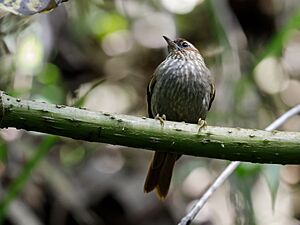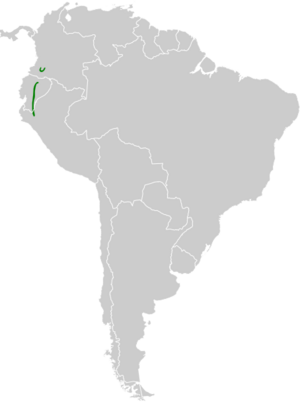Spectacled prickletail facts for kids
Quick facts for kids Spectacled prickletail |
|
|---|---|
 |
|
| Conservation status | |
| Scientific classification | |
| Genus: |
Siptornis
|
| Species: |
striaticollis
|
 |
|
The spectacled prickletail (Siptornis striaticollis) is a small bird that belongs to the ovenbird family called Furnariidae. You can find this bird in the countries of Colombia, Ecuador, and Peru. It's known for its unique look and how it moves.
Contents
About the Spectacled Prickletail
Scientists are still learning about the spectacled prickletail's family tree. It was once thought to be related to birds called greytails. However, new information suggests it might be closer to other bird groups like Roraimia, Cranioleuca, and Thripophaga.
The spectacled prickletail is the only bird in its special group, called a genus, named Siptornis. Most experts agree there are two types, or subspecies, of this bird:
- S. s. striaticollis
- S. s. nortoni
What Does It Look Like?
The spectacled prickletail is a tiny bird. It is about 11 to 12 centimeters (4.3 to 4.7 inches) long. It weighs around 12 to 13 grams (0.42 to 0.46 ounces). Both male and female birds look the same.
This bird has a dark reddish-brown head. It has a whitish stripe above its eyes, like tiny spectacles. Its cheeks are brownish with light streaks. Its back is a rich reddish-brown color. This color gets redder towards its tail.
Its tail feathers are a reddish-chestnut color. The feathers in the middle of its tail look spiny at the ends. This is because they don't have the usual soft parts. Its wings are dark chestnut and brown. The underside of its body is a grayish-olive-brown color. It has thin, light streaks on its throat and upper chest.
The bird's eyes are brown. Its upper beak is dark brown, and its lower beak is pinkish. Its legs and feet are grayish-green or olive-yellow. Young birds have a more reddish-brown head. They also have more streaks on their undersides than adult birds.
Where It Lives and Its Home
The spectacled prickletail lives in the Andes Mountains. You can find it in southeastern Colombia. It also lives along the eastern slopes in Ecuador. Its range extends a little bit into northern Peru.
The S. s. striaticollis subspecies lives in Colombia. The S. s. nortoni subspecies lives in Ecuador and Peru. This bird prefers to live in subtropical montane evergreen forests. These are forests found on mountains in warmer regions.
In Colombia, it lives at heights between 1,200 and 2,500 meters (3,900 and 8,200 feet). In Ecuador, it lives between 1,300 and 2,300 meters (4,300 and 7,500 feet) high.
Bird Behavior
Movement
The spectacled prickletail stays in the same area all year round. It does not migrate to different places.
Feeding Habits
This bird mainly eats arthropods. These are small creatures like insects and spiders. It usually hunts alone or in pairs. Often, it joins groups of different bird species that are feeding together.
It mostly looks for food in the middle or upper parts of the forest trees. It's very agile when it feeds. It climbs and hitches along branches. It can even hang upside down! It probes into moss, plants growing on trees (epiphytes), and cracks in tree bark. It also searches under dead leaves and large live leaves, like those of the Cecropia tree.
Life Cycle
Scientists believe that spectacled prickletails stay with one partner. Their nest is shaped like a ball. It is made of moss and other plant materials. The entrance to the nest is at the bottom. The nest hangs from near the end of a tree branch. Not much else is known about how they raise their young.
Vocalization
The song of the spectacled prickletail is a high-pitched trill. This is a fast, vibrating sound.
Conservation Status
The IUCN (International Union for Conservation of Nature) has evaluated the spectacled prickletail. They have listed it as a species of "Least Concern." This means it is not currently in danger of disappearing.
Its home range is not very large. The exact number of these birds is unknown. However, scientists believe the population is stable. There are no immediate threats that have been found for this bird. It is considered rare to uncommon. It is found in specific areas rather than spread out everywhere.


